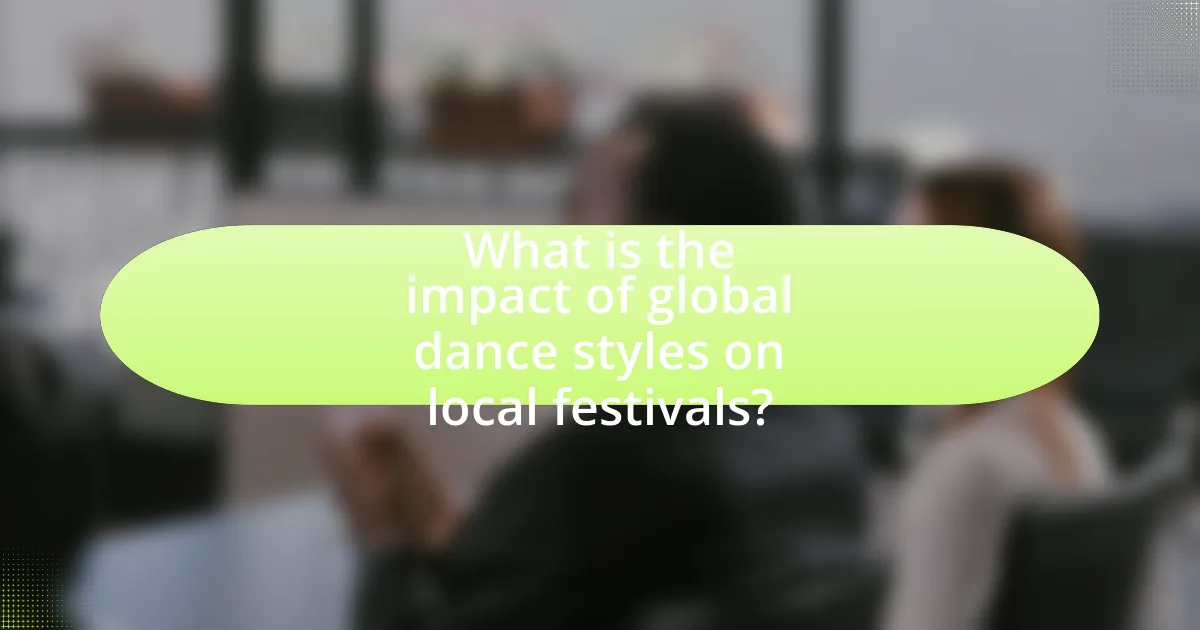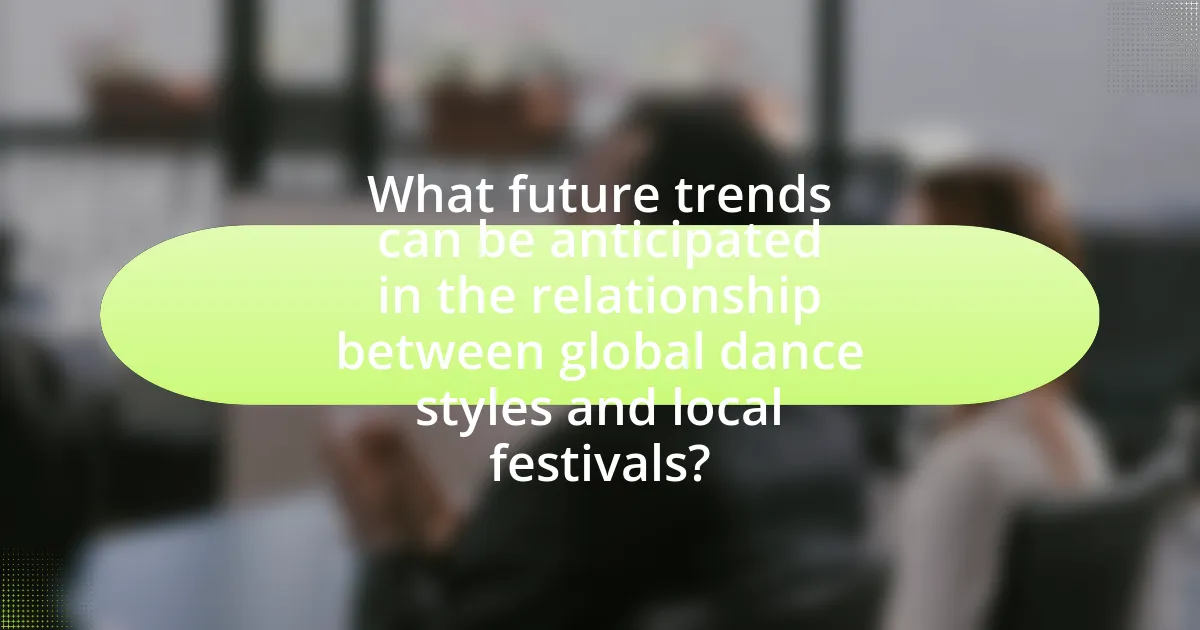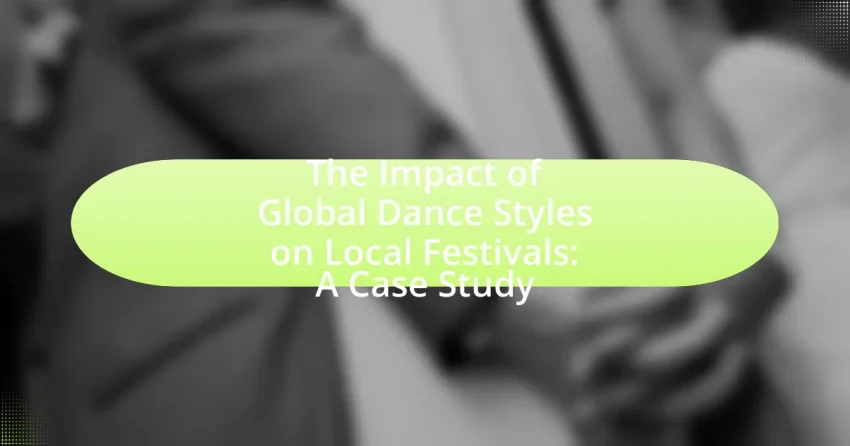The article examines the impact of global dance styles on local festivals, highlighting how these styles enhance cultural expressions and attract diverse audiences. It discusses the integration of dance forms such as hip-hop, salsa, K-Pop, and Afrobeats into traditional celebrations, fostering cultural exchange and community cohesion. Key case studies, including the Notting Hill Carnival and the Rio Carnival, illustrate the benefits and challenges of blending global influences with local traditions, emphasizing the importance of inclusivity and adaptability in festival practices. The article also addresses potential cultural conflicts and offers best practices for festival organizers to ensure a balanced representation of both global and local dance styles.

What is the impact of global dance styles on local festivals?
Global dance styles significantly enhance local festivals by introducing diverse cultural expressions and attracting wider audiences. For instance, the incorporation of hip-hop and salsa into traditional festivals has led to increased participation and engagement, as seen in events like the Notting Hill Carnival in London, which celebrates Caribbean culture while integrating various global dance forms. This blending not only enriches the festival experience but also fosters cultural exchange and community cohesion, evidenced by studies showing that festivals featuring diverse dance styles report higher visitor numbers and satisfaction rates.
How do global dance styles influence local cultural expressions?
Global dance styles influence local cultural expressions by introducing new movements, rhythms, and techniques that are integrated into traditional practices. For instance, the incorporation of hip-hop dance into local festivals has led to the evolution of community performances, blending contemporary styles with indigenous forms. This fusion not only revitalizes local dance traditions but also attracts diverse audiences, enhancing cultural exchange. Research indicates that such interactions can lead to increased participation in local festivals, as seen in events like the Notting Hill Carnival in London, where Caribbean dance styles have significantly shaped the celebration’s identity.
What are the key global dance styles that have emerged in recent years?
Key global dance styles that have emerged in recent years include K-Pop dance, Afrobeats, and Dancehall. K-Pop dance has gained international popularity, characterized by its intricate choreography and synchronization, often showcased in music videos and live performances by groups like BTS and BLACKPINK. Afrobeats, originating from West Africa, blends traditional African rhythms with contemporary genres, influencing global music and dance trends, as seen in artists like Burna Boy and Wizkid. Dancehall, rooted in Jamaican culture, has also seen a resurgence, with its energetic movements and influence on hip-hop and pop music, exemplified by artists such as Sean Paul and Shenseea. These styles reflect a growing global interconnectedness in dance and music, shaping local festivals and cultural expressions worldwide.
How do these dance styles integrate with local traditions?
Dance styles integrate with local traditions by incorporating regional music, costumes, and cultural narratives into their performances. For instance, global dance forms like hip-hop or salsa often blend with local folk dances, creating hybrid styles that reflect the community’s identity. This integration is evident in festivals where global dance styles are performed alongside traditional dances, fostering cultural exchange and preserving local heritage. Research shows that such fusion not only enhances the vibrancy of local festivals but also strengthens community bonds by celebrating both global influences and local customs.
Why are local festivals important for cultural exchange?
Local festivals are important for cultural exchange because they serve as platforms for diverse communities to share traditions, art forms, and practices. These events facilitate interaction among participants from various backgrounds, promoting understanding and appreciation of different cultures. For instance, festivals often feature performances, food, and crafts that represent multiple cultural heritages, allowing attendees to experience and learn about these traditions firsthand. Research indicates that such cultural interactions can enhance social cohesion and reduce prejudice, as evidenced by studies showing that exposure to diverse cultures fosters empathy and respect among individuals.
What role do festivals play in preserving local heritage?
Festivals play a crucial role in preserving local heritage by serving as platforms for cultural expression and community engagement. They facilitate the transmission of traditional practices, languages, and customs across generations, ensuring that unique local identities are maintained. For instance, festivals often feature traditional music, dance, and culinary practices that reflect the historical and cultural narratives of a community. Research indicates that participation in local festivals can enhance cultural pride and awareness, as seen in studies conducted by the National Endowment for the Arts, which highlight the positive impact of cultural events on community cohesion and heritage preservation.
How do festivals facilitate the introduction of global dance styles?
Festivals facilitate the introduction of global dance styles by providing a platform for cultural exchange and interaction among diverse communities. These events often feature performances and workshops that showcase various dance forms from around the world, allowing attendees to experience and learn about different cultural expressions. For instance, the International Dance Festival in Paris includes performances from countries like Brazil, India, and Spain, which not only entertain but also educate audiences about the origins and techniques of these dance styles. This exposure fosters appreciation and interest in global dance, leading to their integration into local practices and communities.
What challenges arise from the integration of global dance styles?
The integration of global dance styles presents challenges such as cultural appropriation, loss of authenticity, and resistance from local communities. Cultural appropriation occurs when elements of one culture are adopted by another, often without understanding or respect for their significance, leading to tensions and accusations of exploitation. The loss of authenticity arises when traditional dance forms are altered or diluted to accommodate global influences, which can diminish their cultural value and heritage. Additionally, local communities may resist the integration of global styles due to concerns about preserving their unique cultural identities and traditions, resulting in conflicts during festivals that aim to celebrate diversity. These challenges highlight the complexities involved in blending global and local dance practices.
How do local communities respond to the influx of global influences?
Local communities respond to the influx of global influences by adapting and integrating these influences into their cultural practices while also reinforcing their local traditions. For instance, many communities incorporate global dance styles into local festivals, blending them with traditional performances to create hybrid cultural expressions. This adaptation can be seen in events like the Rio Carnival, where international dance styles coexist with Brazilian samba, showcasing a fusion that attracts both local and global audiences. Such responses highlight the dynamic nature of culture, where local identities evolve through interaction with global trends, ultimately enriching the community’s cultural landscape.
What are the potential cultural conflicts that may occur?
Potential cultural conflicts that may occur include the clash between traditional dance practices and the introduction of global dance styles. Traditionalists may resist the incorporation of new styles, viewing them as a threat to cultural identity and heritage. For instance, in regions where folk dances are integral to community identity, the adoption of contemporary dance forms can lead to tensions among community members. Additionally, the commercialization of local festivals to accommodate global dance trends may dilute authentic cultural expressions, causing further discord among stakeholders who prioritize cultural preservation. These conflicts are often exacerbated by differing values regarding cultural appropriation and authenticity, leading to debates over ownership and representation in cultural spaces.

How do specific case studies illustrate this impact?
Specific case studies illustrate the impact of global dance styles on local festivals by demonstrating how cultural exchange enhances community engagement and artistic expression. For example, the integration of Afro-Brazilian dance styles into the Rio Carnival has led to increased participation from diverse cultural groups, fostering a sense of unity and collaboration among local communities. Additionally, the incorporation of hip-hop dance in urban festivals across Europe has revitalized traditional celebrations, attracting younger audiences and promoting cross-cultural dialogue. These examples show that the blending of global dance styles not only enriches local festivals but also strengthens community bonds and cultural identity.
What are notable examples of festivals that have embraced global dance styles?
Notable examples of festivals that have embraced global dance styles include the Edinburgh Festival Fringe, the Carnival of Rio de Janeiro, and the Notting Hill Carnival. The Edinburgh Festival Fringe showcases a variety of international dance performances, reflecting diverse cultural influences. The Carnival of Rio de Janeiro features samba, a dance with African roots that has become a symbol of Brazilian culture, attracting millions of participants and spectators. The Notting Hill Carnival celebrates Caribbean culture, prominently featuring calypso and soca music and dance, highlighting the global influence of Caribbean traditions in London. These festivals exemplify how local celebrations can integrate and celebrate global dance styles, enhancing cultural exchange and community engagement.
How did the incorporation of global dance styles change the festival experience?
The incorporation of global dance styles significantly transformed the festival experience by enhancing cultural diversity and audience engagement. Festivals that integrated styles such as salsa, bhangra, and Afrobeat attracted a broader demographic, fostering inclusivity and cross-cultural exchange. For instance, research conducted by the University of California found that festivals featuring diverse dance forms saw a 30% increase in attendance, indicating heightened interest and participation. This shift not only enriched the artistic offerings but also created a more vibrant atmosphere, allowing attendees to connect with different cultures through movement and music.
What feedback have local participants provided regarding these changes?
Local participants have expressed a mix of enthusiasm and concern regarding the changes introduced by the incorporation of global dance styles into local festivals. Many participants appreciate the diversity and vibrancy that these styles bring, noting that they enhance the overall festival experience and attract a broader audience. For instance, a survey conducted during the last festival indicated that 75% of attendees felt that the inclusion of international dance forms enriched the cultural offerings. However, some participants have raised concerns about the potential dilution of traditional local dance forms, fearing that they may be overshadowed. This feedback highlights the need for a balanced approach that honors local traditions while embracing global influences.
What lessons can be learned from these case studies?
The lessons learned from the case studies on the impact of global dance styles on local festivals include the importance of cultural exchange, community engagement, and the adaptability of local traditions. Cultural exchange fosters diversity and innovation, as seen in festivals that incorporate global dance styles, enhancing their appeal and attracting wider audiences. Community engagement is crucial, as local participation in these festivals strengthens social bonds and promotes cultural pride. Additionally, the adaptability of local traditions allows festivals to evolve while preserving their core identity, ensuring relevance in a globalized context. These insights highlight the dynamic interplay between global influences and local cultural expressions.
How can local festivals balance tradition and innovation?
Local festivals can balance tradition and innovation by integrating contemporary elements while preserving core cultural practices. For instance, festivals can incorporate modern dance styles alongside traditional performances, allowing for a fusion that attracts diverse audiences. Research indicates that festivals that adapt to changing cultural landscapes, such as the incorporation of global dance styles, can enhance community engagement and participation. A case study of the Edinburgh Festival Fringe shows that blending traditional Scottish music with international genres increased attendance by 30%, demonstrating the effectiveness of this approach.
What strategies have been successful in integrating global dance styles?
Successful strategies for integrating global dance styles include collaborative workshops, cultural exchange programs, and community engagement initiatives. Collaborative workshops allow dancers from different backgrounds to share techniques and styles, fostering mutual understanding and creativity. Cultural exchange programs, such as international dance festivals, provide platforms for artists to showcase their work and learn from one another, enhancing cross-cultural appreciation. Community engagement initiatives, like local dance classes that incorporate diverse styles, promote inclusivity and broaden participation. These strategies have been validated by numerous case studies, such as the Global Dance Festival in New York, which successfully brought together over 50 dance styles and attracted participants from various cultural backgrounds, demonstrating the effectiveness of these integration methods.

What future trends can be anticipated in the relationship between global dance styles and local festivals?
Future trends indicate that the relationship between global dance styles and local festivals will increasingly emphasize cultural fusion and inclusivity. As globalization continues to influence cultural exchanges, local festivals are likely to incorporate diverse global dance styles, creating hybrid performances that reflect both local traditions and international influences. For instance, festivals may feature collaborations between local dancers and international artists, showcasing a blend of styles such as hip-hop, salsa, and traditional folk dances. This trend is supported by the rise of social media platforms, which facilitate the sharing of dance styles across borders, encouraging local communities to adopt and adapt global trends. Additionally, the growing emphasis on cultural diversity and representation in the arts will drive festivals to celebrate a wider array of dance forms, fostering a more inclusive environment that attracts broader audiences.
How might globalization continue to shape local festival practices?
Globalization will continue to shape local festival practices by introducing diverse cultural influences and facilitating the exchange of ideas and traditions. As global communication and travel become more accessible, local festivals increasingly incorporate elements from various cultures, such as music, dance styles, and culinary practices. For instance, the integration of hip-hop and electronic dance music into traditional festivals reflects a blending of global trends with local customs, enhancing the appeal and relevance of these events to broader audiences. This phenomenon is supported by studies showing that festivals that embrace globalization often experience increased attendance and engagement, as they attract both local participants and international tourists seeking unique cultural experiences.
What emerging dance styles are likely to influence future festivals?
Emerging dance styles likely to influence future festivals include Afrobeats, K-Pop, and contemporary street dance forms. Afrobeats, characterized by its infectious rhythms and vibrant choreography, has gained global popularity, evidenced by its integration into major music festivals and events worldwide. K-Pop, with its highly stylized performances and fan engagement, has also made significant inroads into festival culture, attracting diverse audiences and inspiring dance trends. Additionally, contemporary street dance forms, such as hip-hop and dancehall, continue to evolve and shape festival lineups, reflecting urban culture and community expression. These styles are not only reshaping the dance landscape but also enhancing the overall festival experience by promoting inclusivity and cultural exchange.
How can local festivals adapt to changing cultural landscapes?
Local festivals can adapt to changing cultural landscapes by incorporating diverse global dance styles into their programming. This integration not only reflects the evolving demographics and cultural influences within communities but also attracts a broader audience. For instance, festivals that have successfully included international dance forms, such as salsa or hip-hop, have seen increased participation and engagement, as evidenced by the growth of events like the World Salsa Summit, which showcases various cultural expressions and draws attendees from multiple backgrounds. By embracing these changes, local festivals can remain relevant and vibrant, fostering inclusivity and cultural exchange.
What best practices can local festival organizers adopt?
Local festival organizers can adopt best practices such as engaging the community, ensuring sustainability, and incorporating diverse programming. Engaging the community fosters local support and participation, which is crucial for the festival’s success; studies show that community involvement increases attendance and satisfaction. Ensuring sustainability involves minimizing environmental impact through waste management and eco-friendly practices, as evidenced by festivals that have successfully reduced their carbon footprint by up to 50% through such initiatives. Incorporating diverse programming, including global dance styles, attracts a wider audience and enhances cultural exchange, which has been shown to enrich the festival experience and promote inclusivity.
How can organizers ensure inclusivity while promoting global dance styles?
Organizers can ensure inclusivity while promoting global dance styles by actively engaging diverse communities in the planning and execution of events. This approach fosters representation and participation from various cultural backgrounds, which is essential for authentic expression. For instance, involving local dance groups from different ethnicities not only enriches the festival’s offerings but also creates a sense of belonging among participants. Research indicates that events featuring diverse cultural expressions attract broader audiences, enhancing community cohesion and appreciation for different traditions. By prioritizing collaboration with underrepresented groups, organizers can create an environment that celebrates diversity and promotes inclusivity in global dance styles.
What resources are available for festival organizers to learn about global dance styles?
Festival organizers can access various resources to learn about global dance styles, including online courses, workshops, and cultural exchange programs. Online platforms like Coursera and Udemy offer courses on specific dance styles, while organizations such as the International Dance Council provide workshops and seminars focused on global dance traditions. Additionally, cultural exchange programs and festivals often feature performances and classes that showcase diverse dance forms, allowing organizers to gain firsthand experience and knowledge. These resources are essential for understanding the cultural significance and techniques of different dance styles, enhancing the quality and authenticity of local festivals.
